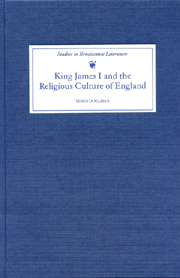Book contents
- Frontmatter
- Preface
- Chapter 1 BEGINNINGS: THE ROOTS OF JAMES' ROLE IN RELIGIOUS CULTURE
- Chapter 2 THE ACCESSION OF KING JAMES I AND ENGLISH RELIGIOUS POETRY
- Chapter 3 PROPHETS AND THE KING
- Chapter 4 KING JAMES, ANDREW MELVILLE AND THE NEO-LATIN RELIGIOUS EPIGRAM
- Chapter 5 FROM CONSTANTINIAN EMPEROR TO REX PACIFICUS: THE EVOLVING ICONOGRAPHY OF JAMES I
- Chapter 6 KING JAMES AND THE POLITICS OF CONVERSION
- Chapter 7 THE SONGS OF DAVID: KING JAMES AND THE PSALTER
- Chapter 8 THE DEATH OF SOLOMON
- WORKS CITED
- Index
Chapter 3 - PROPHETS AND THE KING
Published online by Cambridge University Press: 05 February 2013
- Frontmatter
- Preface
- Chapter 1 BEGINNINGS: THE ROOTS OF JAMES' ROLE IN RELIGIOUS CULTURE
- Chapter 2 THE ACCESSION OF KING JAMES I AND ENGLISH RELIGIOUS POETRY
- Chapter 3 PROPHETS AND THE KING
- Chapter 4 KING JAMES, ANDREW MELVILLE AND THE NEO-LATIN RELIGIOUS EPIGRAM
- Chapter 5 FROM CONSTANTINIAN EMPEROR TO REX PACIFICUS: THE EVOLVING ICONOGRAPHY OF JAMES I
- Chapter 6 KING JAMES AND THE POLITICS OF CONVERSION
- Chapter 7 THE SONGS OF DAVID: KING JAMES AND THE PSALTER
- Chapter 8 THE DEATH OF SOLOMON
- WORKS CITED
- Index
Summary
IN his prose work The Wonderfull Yeare, Thomas Dekker celebrates 1603 as a year noteworthy both for the peaceful accession of a new king in the spring, and the devastating plague of that summer. The outpouring of praise and hope at James' accession has been traced in the previous chapter, but as a time of national crisis this year also elicited a much different kind of poetry. As an “annus mirabilis” it provided an opportunity for outspoken assessment of the state of England, an assessment which sometimes established itself in reference to Israel's prophets. By far the majority of works heralding the new reign were panegyric, with any instruction to the king disguised as praise; however, a few writers did adopt the more radical position of prophet. This chapter will examine two writers who in 1603 adopted a moderately prophetic stance in their writings to the king, and then compare these with the developing prophetic mode of George Wither, and the general tendency to more outspoken prophecies that emerged in the period 1619–25. However, before these individual figures can be turned to, we must consider the tradition of prophecy, as understood by Protestantism generally, and English Protestantism particularly.
James' English subjects recognized that while their new monarch had a high view of his own authority, he also saw a role for Protestant prophetic utterances and interpretation of biblical books.
- Type
- Chapter
- Information
- King James I and the Religious Culture of England , pp. 39 - 56Publisher: Boydell & BrewerPrint publication year: 2000

